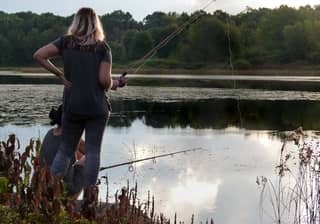
Fishing was something I took up as an activity to do together with my family when my kids were young and now that our kids are older – and don’t seem to want to hang out with their parents as much any more – has since turned into an opportunity to spend a day with my wife at a quiet lake or stream in the mountains – usually somewhere in the Uinta range in Utah.
Not being raised participating in the sport, we resorted to learning a lot from the school of hard knocks. We’d ask a lot of annoying questions to those around us who seemed to know what they were doing; subscribed to fishing magazines; read a lot of articles as they became available online; and, the most frustrating for me, lost a lot of fish!
One of the hardest skills for me to develop (I’m still learning and tuning this) has been how to tell when you have a fish on your line and knowing when to set the hook. Sometimes setting hook too early yanks bait right out of the fish’s mouth, spooking the fish and he’s gone for good. I’ve lost more than my fair share doing this in my excitement to finally land one (usually after hours of getting skunked). I’d jump up and down and shake my fist yelling “argh!” in my frustration about the effort and loss. My wife would just laugh at the spectacle!
So to reign it in, we’d often find ourselves waiting until the fish takes and runs with the bait swallowing it in the process. This is fine if we plan on keeping the fish, but it makes catching and safely releasing the fish a little more difficult without severely injuring it or having to decide to cut the line, leaving the hook in – which again is not ideal. It’s better if you can time the hook set correctly in order to catch the fish in the mouth or lip. It makes it easier to get the hook out so you can get back to fishing faster, and it’s easier on the fish if you planned on releasing it back to fight another day.
Not every strike is hard and obvious – the fish jerking the rod or aggressively taking the bobber, clearly sinking it several times and then swimming off with it. Often the take is subtle, with barely a noticeable twitch in the line and you only notice the fish was there when you begin reeling in to check your bait.
Sensitivity Training
True, some increased sensitivity can be attributed to better equipment – a little nicer rod or reel. But one of the best ways to get a better feel for when there’s a fish on the line is through experience! Spending some time at a stocked community pond if you’re fortunate enough to live close to one is one way to give yourself plenty of opportunities to catch a lot.
Another way to learn what a bite feels like compared to just hitting a log or rock would be to practice what those things feel like. Just find some shallow, clear water to practice in using only a sinker to drag across the bottom and focus, paying close attention to what it feels like as you drag the sinker over rocks, sticks, and along the bottom. Training yourself this way will help you know when it’s NOT one of those things and when you should set the hook instead!
Detection Techniques
One technique to gauging when it’s a fish toying with the bait is to start watching the line just as soon as it hits the water. Watch for twitches or movement as your bait sinks and after it’s settled, be sure to reel in any slack watching the line closely. Sometimes you’ll see a tight line suddenly get slack in it. This can happen when a fish picks up the bait and swims towards you. At which time you need to point your rod at it while reeling in real quick and set the hook faster than the fish is swimming.
While you’re waiting for a bite, be sure to keep a relaxed grip on the pole allowing the rod’s handle to rest on the tip of your index finger. This will help you better feel all the vibrations ticking through the rod. Similar to when you’re feeling your own pulse. Too tight a grip and you won’t be able to feel as much.
Another technique I like to use that allows me to feel what’s happening on the line involves extending my forefinger down, lightly touching the line just above the bail. Concentrate on any ticks and bumps you feel.
Stay focused!
For some, fishing is sit back and relax, checking the line from time to time to see if anything’s taken the bait – but most times for me the fishing tends to be very active. I’ve found that actively watching, feeling, and concentrating has helped me catch more fish on purpose instead of just occasionally by accident. But whatever your preference, I hope I’ve given you some good ideas to help you get better at knowing when you have a fish at the end of your line.
